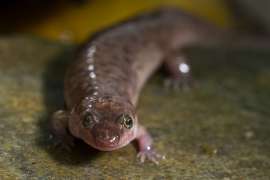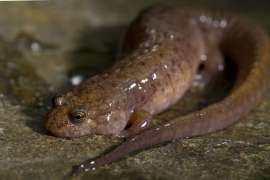Seal Salamander
Seal Salamander
The seal salamander is one of a large group of species generally known as stream salamanders. Always secretive, and often nocturnal, they rarely stray from water. They do not have lungs. Adults have no lungs and absorb oxygen directly through their skin.
Desmognathus monticola
Insectivore
North America [VIEW MAP]
Mountains, Wetlands, Woodlands
Seal salamanders are secretive and usually prefer to wedge themselves under rocks and crevices, so look carefully.
Photos and Videos
The eastern U.S. has the greatest diversity of salamander species in the world, and salamanders are central to the ecological function of eastern salamanders. Some areas can be home to 3 or 4 salamanders per square yard of streambed or forest floor.
The name “seal salamander” comes from the posture the animal holds when alert.
Seal salamanders have well-developed feet that aid in moving among the pebbles and rocks on the bottoms of swift-moving streams. Salamanders are the only vertebrates capable of regeneration of feet, toes, hands and even limbs.
Males maintain small territories and learn to identify rival neighboring males, and studies have shown that they acknowledge shared borders so that they do not waste energy fighting the same rival day after day. Wandering males are quickly chased away, while females are allowed to roam freely.
Like many other salamanders, seal salamanders have complex mating rituals. Males perform a series of ritualized body movements and deposit sperm onto a rock or submerged leaf in hopes that a female has been attracted by his movements.
Eggs are laid in the stream, usually adhering to the underside of a small rock, and the female guards the eggs until they hatch. The young hatch as larvae that mostly resemble the adults, but with bushy gills on either side of the head. The larvae are suction feeders in the water.
The larval stage can last for years, and the larvae never leave the water. After metamorphosis into non-gilled, lungless adults, the salamanders will live mostly along the margins of small creeks and seeps, hiding under rocks in very shallow water.
Seal salamanders are secretive and usually prefer to wedge themselves under rocks and crevices, so look carefully.
This species occurs along a broad region of the Appalachian Mountain Chain, from Pennsylvania southward to Georgia and Alabama.
This species is most commonly associated with clear seeps and springs, as well as smaller streams, in forested upland areas such as Georgia’s Blue Ridge region.
Wild diet includes tiny aquatic insects and other invertebrates such as caddisflies or worms. Zoo Atlanta’s Herpetology Team maintains breeding colonies of a wide variety of such invertebrates, including fruit flies, crickets, beetles and others, to ensure the greatest breadth of diet possible. Their food items also are dusted with specially developed vitamin and mineral powders.
Zoo Atlanta staff has been heavily involved in the basic research necessary to understand the causes, effects and pathways of epidemics of amphibian chytridiomycosis across North and Central America. Our collaborative work has shown that, while the dreaded disease occurs in our regional stream salamander species, it does not appear to be causing the terrible deadly epidemics seen in other areas. So, while this is good news for the time being, more work is needed to better understand why the disease appears to be relatively harmless in our region.



